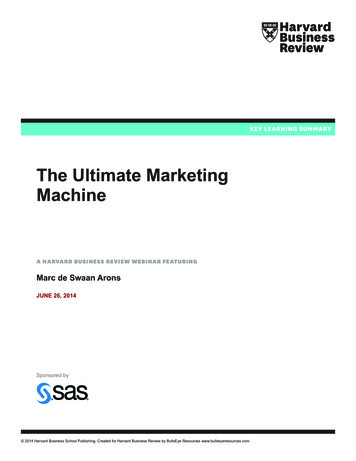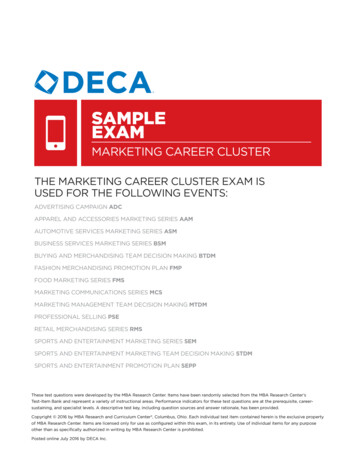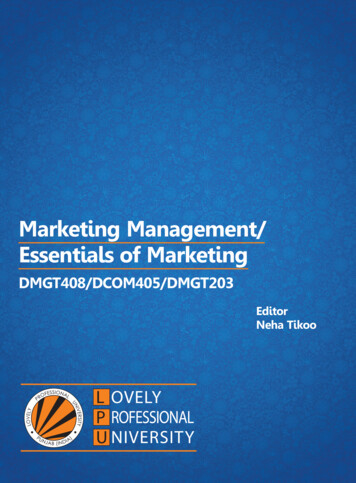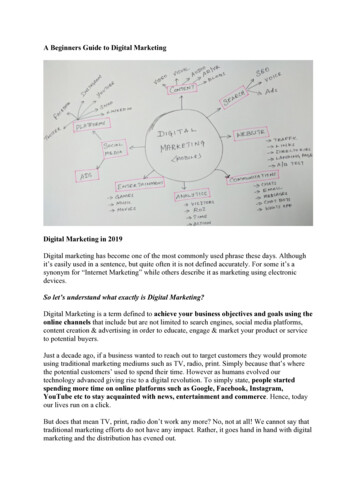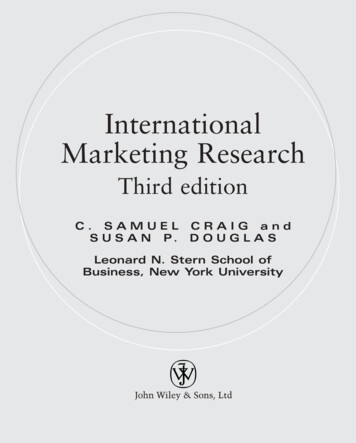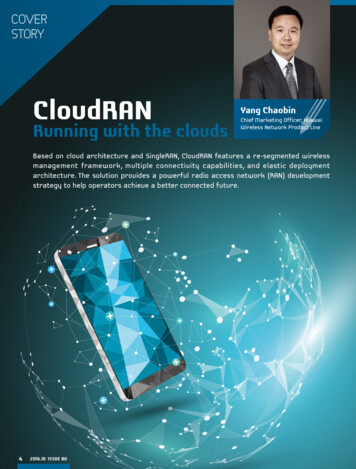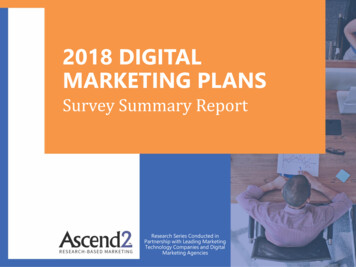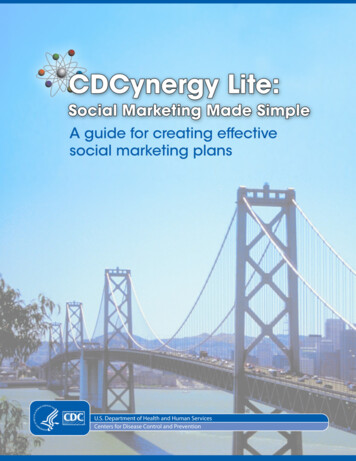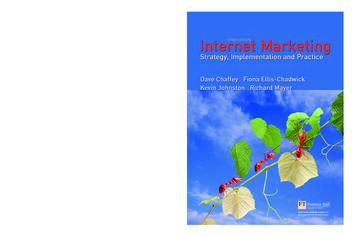
Transcription
0273694057 COVER11/5/0613:48Page 1‘Comprehensive, up-to-date and practical in focus.’Dr Lisa Harris, Brunel UniversityInternet Marketing: Strategy, Implementation and Practice, Third Edition provides a comprehensive guide to how organisationscan use the Internet to support their marketing activities, and covers all aspects of Internet marketing — environment,analysis, strategy development, and digital marketing campaign-planning and execution.The book is based on emerging academic models and examples of best practice from leading experts in digital media.The practical knowledge developed through reviewing these concepts and practices will enable the reader to exploit theopportunities of marketing using the Internet while minimising risks.New features in this edition include: In-depth global cases illustrating best practice and the challenges of online marketing from well-known globale-businesses, including Amazon and eBay Updated references to the full range of digital media, including blogging, RSS, instant messaging, podcasting,digital TV and mobile marketing Improved four-colour design to increase clarity and ease readability Greater focus on strategy and development, with a revised chapter on Improving E-Marketing PerformanceA Companion Website at www.pearsoned.co.uk/chaffey contains additional study materials for students, as well asextensive links to relevant websites and extra pedagogical resources designed for lecturers.Fiona Ellis-Chadwick is a lecturer in Marketing at the Business School at Loughborough University and is a member of theMarketing and Retailing Research Group. Her work has been published in Journal of Business Research, InternationalJournal of Retail Distribution and Management, European Journal of Marketing, Internet Research, and Journal of Retailing andConsumer Services.Richard Mayer is a Senior Lecturer in Marketing at the University of Derby, where he is the programme manager for CIMqualifications. He is also the Director of his own Marketing Training Company, specialising in Strategic Marketing, Businessto Business Marketing and Marketing Communications.Kevin Johnston is a Senior Lecturer at Liverpool John Moores University, specialising in marketing, strategy and e-commerce.He previously lectured at the University of Derby, where he created one of the UK’s first e-commerce degree programmes.THIRDEDITIONChaffey JohnstonEllis-Chadwick MayerDave Chaffey (www.davechaffey.com) is an Internet Marketing trainer and consultant for Marketing Insights Limited. He isa lecturer on e-marketing courses at Cranfield and Warwick Universities and the Institute of Direct Marketing. Dave hasbeen recognised by the CIM as one of the 50 marketing 'gurus' worldwide who have shaped the future of marketing.Internet MarketingDr Ahmad Jamal, Cardiff Business SchoolStrategy, Implementation and Practice‘The authors have been highly successful in showing that they not only understand the relevant academicliterature but are also familiar with the complexities of real life experienced by many practitioners.’ISBN 0-273-69405-7Additional student support atwww.pearsoned.co.uk/chaffey9 780273 694052An imprint ofCover image: Eureka/Alamywww.pearson-books.comAdditional student support atwww.pearsoned.co.uk/chaffey
INMA A01.QXD17/5/0612:00Page iInternet MarketingStrategy, Implementation and PracticeVisit the Internet Marketing, third edition Companion Website atwww.pearsoned.co.uk/chaffey to find valuable student learning materialincluding: Web links to case study materials, academic articles and examples ofbest practice Guidance on tools and techniques for effective web sites A comprehensive online glossary
INMA A01.QXD17/5/0612:00Page iiWe work with leading authors to develop the strongesteducational materials in business and management,bringing cutting-edge thinking and best learning practiceto a global market.Under a range of well-known imprints, includingFinancial Times Prentice Hall, we craft high quality printand electronic publications which help readers tounderstand and apply their content, whether studyingor at work.To find out more about the complete range of ourpublishing please visit us on the World Wide Web at:www.pearsoned.co.uk
INMA A01.QXD17/5/0612:00Page iiiThird EditionInternet MarketingStrategy, Implementation and PracticeDave ChaffeyFiona Ellis-ChadwickRichard MayerKevin Johnston
INMA A01.QXD17/5/0612:00Page ivPearson Education LimitedEdinburgh GateHarlowEssex CM20 2JEEnglandand Associated Companies throughout the worldVisit us on the World Wide Web at:www.pearsoned.co.ukFirst published 2000Second edition published 2003Third edition published 2006 Pearson Education Limited 2000, 2003, 2006The right of Fiona Ellis-Chadwick to be identified as author ofthis work has been asserted by her in accordance with theCopyright, Designs and Patents Act 1988.All rights reserved. No part of this publication may be reproduced, stored in a retrievalsystem, or transmitted in any form or by any means, electronic, mechanical,photocopying, recording or otherwise, without either the prior written permission of thepublisher or a licence permitting restricted copying in the United Kingdom issued by theCopyright Licensing Agency Ltd, 90 Tottenham Court Road, London W1T 4LP.All trademarks used herein are the property of their respective owners. The use of anytrademark in this text does not vest in the author or publisher any trademark ownership rightsin such trademarks, nor does the use of such trademarks imply any affiliation with orendorsement of this book by such owners.ISBN-13: 978-0-273-69405-2ISBN-10: 0-273-69405-7British Library Cataloguing-in-Publication DataA catalogue record for this book is available from the British LibraryLibrary of Congress Cataloging-in-Publication DataA catalogue record for this book is available from the Library of Congress10 9 8 7 6 5 4 3 2 110 09 08 07 06Typeset in 9/12.5pt Stone Serif by 30Printed and bound by Mateu Cromo Artes Graficas, SpainThe publisher’s policy is to use paper manufactured from sustainable forests.iv
INMA A01.QXD17/5/0612:00Page vBrief contentsPrefaceGuided tourAbout the authorsAcknowledgementsxiiixxiixxvxxviPart 1 Internet marketing fundamentals1An introduction to Internet marketing2The Internet micro-environment413The Internet macro-environment973Part 2 Internet strategy development4Internet marketing strategy1515The Internet and the marketing mix2146Relationship marketing using the Internet256Part 3 Internet marketing: implementation and practice7Delivering the online customer experience3018Interactive marketing communications3489Maintaining and monitoring the online presence41510Business-to-consumer Internet marketing45111Business-to-business Internet marketing484GlossaryIndex514534v
INMA A01.QXD17/5/0612:00Page vi1
INMA A01.QXD17/5/0612:00Page viiContentsPrefaceGuided tourAbout the authorsAcknowledgementsxiiixxiixxvxxviPart 1INTERNET MARKETING FUNDAMENTALS1 An introduction to Internet marketing3Learning objectives / Questions for marketers /Links to other chapters3Introduction – how significant is the Internet formarketing?Marketing applications of Internet marketingOur changing media consumptionOur changing buyer behaviour4567What is Internet marketing?E-marketing definedDigital marketing definedE-commerce and e-business definedE-business definedBusiness or consumer model?8910111112What benefits does the Internet provide for themarketer?14A strategic approach to Internet marketing18How do Internet marketing communications differfrom traditional marketing communications?20A short introduction to Internet technologyHow does the Internet work?From the Internet to intranets and extranets262732Case Study 1 eBay thrives in the nt exercisesEssay and discussion questionsExamination questionsIntroductionDifferent environment components4243MarketplaceCompetitive forcesValue creation and value chain analysisNew channel structuresLocation of trading in marketplaceCommercial arrangement for transactionsBusiness models in e-commerceRevenue models4546495357585961CustomersAssessing demand for e-commerce servicesOnline demand for business services616272Online buyer behaviourCustomer persona and scenario analysisMulti-channel customer experiencesModels of online buyer aries86Case Study 2 Zopa launches a new lending model90Summary92ExercisesSelf-assessment exercisesEssay and discussion questionsExamination questions93939394ReferencesFurther readingWeb links9496963 The Internet macro-environment97Learning objectives / Questions for marketers /Links to other chapters9738383838Introduction98Social factorsSocial exclusion99100ReferencesFurther readingWeb links393940Legal and ethical issues of Internet usagePrivacy legislationOther e-commerce legislation1011011132 The Internet micro-environment41Learning objectives / Questions for marketers /Links to other chapters41Technological factorsAlternative digital technologiesDigital radioSecurity116120129131vii
INMA A01.QXD17/5/0612:00Page viiiCONTENTSEconomic factorsGlobalisation136137Political factorsInternet governanceTaxationTax jurisdiction138139140140Case Study 3 Boo hoo – learning from the largestEuropean dot-com failure141209ExercisesSelf-assessment exercisesEssay and discussion questionsExamination questions210210210211ReferencesFurther readingWeb links211213213Summary144ExercisesSelf-assessment exercisesEssay and discussion questionsExamination questions1441441441455 The Internet and the marketing mix214Learning objectives / Questions for marketers /Links to other chapters214Introduction215ReferencesFurther readingWeb links145146147ProductThe long tail conceptThe Internet and brandingThe importance of brand online217223224229Price1 Increased price transparency2 Downward pressure on price3 New pricing approaches (including auctions)4 Alternative pricing structure or policies231231233235237Place1 Place of purchase2 New channel structures3 Channel conflicts4 Virtual organisations237238240240242Promotion243People, process and physical evidencePeopleProcessPhysical evidence245245248248Case Study 5 The re-launched Napster changesthe music marketing mix248Summary251ExercisesSelf-assessment exercisesEssay and discussion questionsExamination questions252252252252ReferencesFurther readingWeb links2532552556 Relationship marketing using theInternet256Learning objectives / Questions for marketers /Links to other chapters256Introduction257Key concepts of relationship marketing258Part 2INTERNET STRATEGY DEVELOPMENT4 Internet marketing strategy151Learning objectives / Questions for marketers /Links to other chapters151IntroductionInternet strategy is a channel marketing strategyThe scope of Internet marketing strategy152152153An integrated Internet marketing strategyIs a separate Internet marketing plan needed?154154A generic strategic approach157Situation reviewInternal audit or analysisExternal audits or analysis160160166Strategic goal settingFrameworks for objective setting168172Strategy formulationDecision 1: Market and product developmentstrategiesDecision 2: Business and revenue models strategiesDecision 3: Target marketing strategyDecision 4: Positioning and differentiationstrategy (including the marketing mix)Decision 5: Multi-channel distribution strategyDecision 6: Multi-channel communicationsstrategyDecision 7: Online communications mix and budgetDecision 8: Organisational capabilities (7S)174Strategy implementationCase Study 4 Tesco.com uses the Internet tosupport its diversification strategyviiiSummary176179180185191194196197204207
INMA A01.QXD17/5/0612:00Page ixCONTENTSBenefits of relationship marketingDifferentiating customers by value258260Key concepts of electronic customer relationshipmanagement (e-CRM)Benefits of e-CRMMarketing applications of CRMCRM technologies and data262263264264Customer lifecycle managementPermission marketingPersonalisation and mass customisationOnline and multi-channel service quality267268270272Approaches to implementing e-CRMStage 1: Attract new and existing customers to siteStage 2a: Incentivise visitors to actionStage 2b: Capture customer information tomaintain relationshipStage 3: Maintain dialogue using onlinecommunicationStage 4: Maintain dialogue using offlinecommunicationThe IDIC approach to relationship buildingTechniques for managing customer activity andvalueLifetime value modellingLoyalty schemesVirtual communitiesCustomer experience – the missing elementrequired for customer loyalty272273273273275276277278278286288290Case Study 6 Boots mine diamonds in theircustomer data291Summary293ExercisesSelf-assessment exercisesEssay and discussion questionsExamination questions294294294294ReferencesFurther readingWeb links295296296Part 3INTERNET MARKETING:IMPLEMENTATION AND PRACTICEWeb site prototyping308Initiation of the web site projectDomain name registrationSelecting an Internet service provider (ISP)309309310Researching site users’ requirementsUsabilityWeb accessibilityLocalisationReviewing competitors’ web sitesDesigning the information architecture312312314317317318Designing the user experienceDeveloping customer-oriented contentMarketing-led site designElements of site designSite design and structurePage designContent design322323324324324332332Development and testing of contentTesting contentTools for web site development and testing334334334Promote site335Service EmpathyThe relationship between service quality, customersatisfaction and loyalty335336337337338338339Case Study 7 Refining the online customerexperience at dabs.com341Summary343ExercisesSelf-assessment exercisesEssay and discussion questionsExamination questions344344345345ReferencesFurther readingWeb links3453473478 Interactive marketing communications 3487 Delivering the online customerexperience301Learning objectives / Questions for marketers /Links to other chapters301Introduction302Planning web site design and build304Who is involved in a web site project?306Learning objectives / Questions for marketers /Links to other chapters348Introduction349The characteristics of interactive marketingcommunicationsDifferences in advertising between traditional anddigital mediaIntegrated Internet marketing communicationsIntegration through timeCampaign response mechanics350354357360362ix
INMA A01.QXD17/5/0612:00Page xCONTENTSObjectives and measurement for interactivemarketing communicationsConversion marketing objectivesTimescales for objective settingCampaign cost objectivesOffline promotion techniquesAdvantages and disadvantages of using offlinecommunications to support e-commerceIncidental and specific advertising of the onlinepresencePublic relationsDirect marketingOther physical remindersWord of mouthx363365366367ReferencesFurther readingWeb links4114134133709 Maintaining and monitoring the online415presence371Learning objectives / Questions for marketers /Links to other chapters415Introduction416Performance management for Internet marketingStage 1: Creating a performance managementsystemStage 2: Defining the performance metricsframeworkStage 3: Tools and techniques for collectingmetrics and summarising results417371372372372373Online promotion techniques3731 Search engine marketing(a) Search engine optimisation (SEO)(b) Pay-per-click (PPC) search marketing(c) Trusted feed3733763813832 Online PRWhat is PR?What is online PR?Differences between online PR and traditional PROnline PR activities3843843853853863 Online partnerships(a) Affiliate marketing(b) Online sponsorship418420424The maintenance processHow often should material be updated?433434Responsibilities in web site maintenanceWho owns the process?Who owns the content?Who owns the format?Who owns the technology?Content management435435438438438440388388390Case Study 9 Learning from Amazon’s cultureof metrics441Summary4464 Interactive advertisingFundamentals of online advertisingThe purpose of interactive advertisingMeasurement of interactive ad effectivenessInteractive ad targeting optionsInteractive ad formatsMaking banner advertising workBuying ssessment exercisesEssay and discussion questionsExamination questions447447448448ReferencesFurther readingWeb links4484494495 E-mail marketingOpt-in e-mail options for customer acquisitionOpt-in e-mail options for prospect conversion andcustomer retention (house list)E-mail marketing success factorsManaging inbound e-mail communications39739810 Business-to-consumer Internetmarketing451Learning objectives / Questions for marketers /Links to other chapters4516 Viral marketing400IntroductionKey themes and concepts452452On-site promotional techniques402Selecting the optimal communications mix403Online customersWho are the online customers?Online customers’ expectations and motivations453453457Case Study 8 Making FMCG brands sizzle online407Summary409ExercisesSelf-assessment exercisesEssay and discussion questionsExamination questions410410411411E-retailingDevelopment of e-retailingE-retailing: the virtual channel462462467E-retail activitiesInformation functionsInteractive functions467467468398399400
INMA A01.QXD17/5/0612:00Page xiCONTENTSWho are the e-retailers and what are they selling? 469Implications for e-retail marketing strategy472Case Study 10 lastminute.com: establishing andmaintaining a competitive position478Summary480ExercisesSelf-assessment exercisesEssay and discussion questionsExamination questions481481481481ReferencesFurther readingWeb links48148348311 Business-to-business Internetmarketing484Learning objectives / Questions for marketers /Links to other chapters484IntroductionKey themes and concepts485485B2B e-contextOnline environment analysis486486Commercial exchanges in B2B markets493The electronic marketplace493How organisations are using Internet technologies 495Trading relationships in B2B marketsThe exchange processThe buying functionTrading partnerships501502502503Digital marketing strategies504Case Study 11 Growth, volume and dispersion ofelectronic markets506Summary510ExercisesSelf-assessment exercisesEssay and discussion questionExamination question511511511511ReferencesFurther readingWeb links511513513GlossaryIndex514534xi
INMA A01.QXD17/5/0612:00Page xiiSupporting resourcesVisit www.pearsoned.co.uk/chaffey to find valuable online resources.Companion Website for students Web links to case study materials, academic articles and examples of bestpracticeGuidance on tools and techniques for effective web sitesA comprehensive online glossaryFor instructors Complete, downloadable Instructor’s ManualPowerPoint slides that can be downloaded and used as OHTsFor more information please contact your local Pearson Education salesrepresentative or visit www.pearsoned.co.uk/chaffey.OneKey: All you and your students need to succeedOneKey is an exclusive new resource for instructors andstudents, giving you access to the best online teaching andlearning tools 24 hours a day, 7 days a week.OneKey means all your resources are in one place formaximum convenience, simplicity and success.Convenience. Simplicity. Success.A OneKey product is available for Internet Marketing, third edition for use withBlackboard , WebCT and CourseCompass. It contains: Interactive Study Guide Assessment questions to test your understanding Flashcards to aid revision Video cases to give you real world applicationFor more information about the OneKey product please contact your local PearsonEducation sales representative or visit www.pearsoned.co.uk/onekey.
INMA A01.QXD17/5/0612:00Page xiiiPrefaceIntroductionThe Internet – opportunity and threatThe Internet represents a tremendous opportunity. For customers, it gives a much widerchoice of products, services and prices from different suppliers and the means to selectand purchase items more readily. For organisations marketing these products and services it gives the opportunity to expand into new markets, offer new services andcompete on a more equal footing with larger businesses. For those working within theseorganisations it gives the opportunity to develop new skills and to use the Internet toimprove the competitiveness of the company.At the same time, the Internet gives rise to many threats to organisations. For example, start-up companies such as Amazon (books) (www.amazon.com), Expedia (travel)(www.expedia.com), AutoByTel (cars) (www.autobytel.com) and CDWOW (CDs)(www.cdwow.com) have captured a significant part of their market and struck fear intothe existing players. Indeed the phrase ‘amazoning a market sector’ has become anoften-used expression among marketers.The Internet – management issuesWith the success stories of companies capturing market share together with the rapidlyincreasing adoption of the Internet by consumers and business buyers has come a fastgrowing realisation that all organisations must have an effective Internet presence toprosper, or possibly even survive! Michael Porter has said:The key question is not whether to deploy Internet technology – companies have nochoice if they want to stay competitive – but how to deploy it.What are these challenges of deploying Internet and digital technology? Figure 1 givesan indication of the marketing activities that need to be managed effectively which arecovered in this book.The figure shows the range of different marketing activities or operating processesneeded to support acquiring new customers through communicating with them onthird-party web sites, attracting them to a company web site, converting them to saleand then using online media to encourage further sales. Applying the Internet as part ofmulti-channel marketing to support customer journeys through different media is also amajor theme throughout this text. Management processes related to Internet marketinginclude planning how Internet marketing can be best resourced to contribute to theorganisation and integrate with other marketing activities. The increased adoption ofInternet marketing also implies a significant programme of change that needs to bemanaged. New forms of objectives need to be set, new communications strategies developed and staff developed through new responsibilities and skills.xiii
INMA A01.QXD17/5/0612:00Page xivOperating processesP R E FAC tion andgrowthSearch engine optimisationProposition developmentProposition developmentPay Per Click searchContent creationOutbound communicationsPartnerships/affiliatesContent managementE-mail marketingOnline ads/sponsorshipMerchandisingCustomer managementE-mail marketingSite usability and accessibilityTouch strategy definitionOnline PRDesign and developmentLoyalty programmesOffline campaignsCustomer servicePersonalisationSupporting processesPerformance improvement including management information, web analytics and customer analysisDesign guidelines and operating proceduresManagement processesTechnical infrastructure including service level managementStrategy and planningManaging relationshipsCreating the visionAssessing technological innovationInterfacing with senior managementMarket analysis and competitor benchmarkingInterfacing with marketing and corporatecommunicationsFinancial analysis and modellingInterfacing with ITDefining the multichannel customer experienceManaging customer informationStaff development, education and retentionAnnual planning and budgetingManaging external relationshipsVendor selection and managementIT project and campaign planning and managementManaging improvement and changeFigure 1 Key organisational processes for Internet marketingSource: E-consultancy (2005), author Dave ChaffeyThe Internet – new skills required?The aim of this text is to provide you with a comprehensive guide to the concepts, techniques and best practice to support all the digital marketing processes shown in Figure 1.This book is based on emerging academic models together with best practice from leading adopters of digital media. The practical knowledge developed through reviewingthese concepts and best practice is intended to enable graduates entering employmentand marketing professionals to exploit the opportunities of marketing using the Internetwhile minimising the risks.xiv
INMA A01.QXD17/5/0612:00Page xvP R E FAC ESpecifically, this book addresses the following needs: There is a need to know to what extent the Internet changes existing marketing modelsand whether new models and strategies can be applied to exploit the medium effectively.Marketing practitioners need practical Internet marketing skills to market their products effectively. Knowledge of the new jargon – terms such as ‘portal’, ‘clickthrough’,‘cookie’, ‘hits’, ‘page impressions’, ‘digital certificate’ – and of effective methods ofsite design and promotion such as search engine marketing will be necessary, eitherfor direct ‘hands-on’ development of a site or to enable communication with otherstaff or agencies that are implementing and maintaining the site.Given the rapidly changing market characteristics and best practices of Internet marketing, web-based information sources are needed to update knowledge regularly.This text and the supporting companion web site contain extensive links to web sitesto achieve this.The content of this book assumes some existing knowledge of marketing in the reader,perhaps developed through experience or by students studying introductory modules inmarketing fundamentals, marketing communications or buyer behaviour. However, thetext outlines basic concepts of marketing, communications theory, buyer behaviour andthe marketing mix.Changes for the third edition of Internet MarketingThe acclaimed structure of the second edition has been retained since this provides a clearsequence to the stages of strategy development and implementation which are requiredto plan successfully for Internet marketing in existing and start-up companies. The thirdedition is a significant update with many revisions, new subsections and nearly 100 newfigures to better explain Internet marketing concepts. The main changes are: In-depth cases written specifically for this book, illustrating best practices and thechallenges of online marketing from well-known global e-businesses such as Amazonand eBay to European and Asian examples such as Tesco.com, dabs.com and start-upssuch as Zopa.com. A full listing of cases is given in Table 1. Mini case studies andexamples within each chapter have also been updated to include the full range ofInternet marketing applications from transactional sites, lead-generation relationshipbuilding sites, brand sites and media-owned sites;Updated to reference the full range of digital media that support Internet marketingincluding blogging, Really Simple Syndication (RSS), instant messaging, podcasting,digital TV and mobile marketing;More detail on understanding online buyer behaviour and the need to deliver effective online customer experiences consistent with this (Chapter 2);Updates on the legal constraints from data protection and privacy laws and accessibility legislation (Chapter 3);Additional coverage on the opportunities provided by technological developments inwireless and mobile media and broadband adoption (Chapter 3);Content on strategy updated to reflect the latest thinking on customer-centric onlinemarketing using customer personas and journeys as part of multi-channel marketing(Chapters 4 and 5);Chapter 6 on relationship marketing now has an approach oriented to electronic customer relationship management (e-CRM) and includes more detail on techniquesused by e-retailers and e-mail marketers such as lifetime value and recency-frequencymonetary (RFM) value analysis;Greater depth on online marketing communications techniques including affiliatemarketing, search engine marketing, online PR and viral marketing (Chapter 8);xv
INMA A01.QXD17/5/0612:00Page xviP R E FAC E Coverage on the latest approaches to using web analytics to measure and improveInternet marketing (Chapter 9).Chapter 10 provides more detailed insight into online consumers and their behaviourand examines how retailers are responding to the challenges created by raised customer expectations.Expanded discussion of B2B trading, trading partnerships and digital marketing strategies.Table 1 In-depth case studies in Internet Marketing, 3rd editionChapterCase studyThemes1IntroductioneBay thrives in the global marketplaceBusiness and revenue model, proposition,competition, objectives and strategies,risk management2Micro-environmentZopa launches a new lending modelAssessing a consumer market, businessmodels, marketing communications3Macro-environmentBoo hoo – learning from thelargest European dot-com failureCompanion vision, branding, target market,communicating the proposition, challengesand reasons for failure4Internet marketingstrategyTesco.com uses the Internet to support itsdiversification strategyBusiness models, proposition and onlineproduct range, target market strategy5Internet marketing mixThe re-launched Napster changes themusic marketing mixPeer-to-peer services, revenue models,proposition design, strategy, competition,risk factors6Relationship marketingBoots mine diamonds in their customerdataInfluence of web site design on conversion,retention marketing, personalisation,e-CRM, RFM analysis7Online customerexperienceRefining the online customerexperience at dabs.comStrategy, proposition, site design, on-sitesearch capabilities8Interactive marketingcommunicationsMaking FMCG brands sizzle onlineCommunications mix, characteristics ofdigital media, applying online communicationstools to support brands such as Birds Eye,Pepperami, Lynx and Persil.9Maintaining andmonitoring the onlinepresenceLearning from Amazon’s cultureof metricsStrategy, measurement, online marketingcommunications, personalisation approach10Busines
Preface xiii Guided tour xxii About the authors xxv Acknowledgements xxvi 1 An introduction to Internet marketing 3 2 The Internet micro-environment 41 3 The Internet macro-environment 97 4 Internet marketing strategy 151 5 The Internet and the marketing mix 214 6 Relationship marketing using the Internet 256 7 Deli


